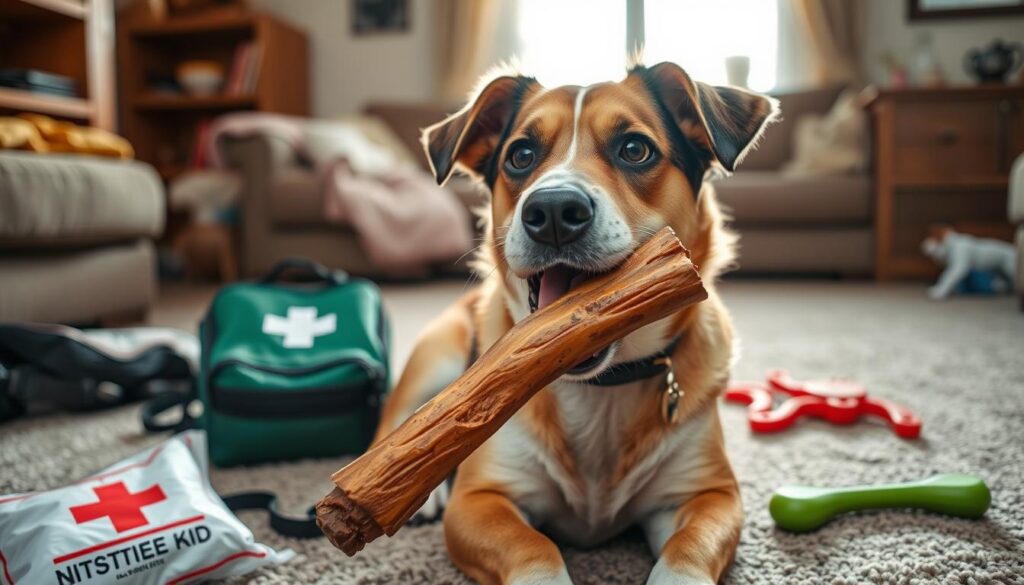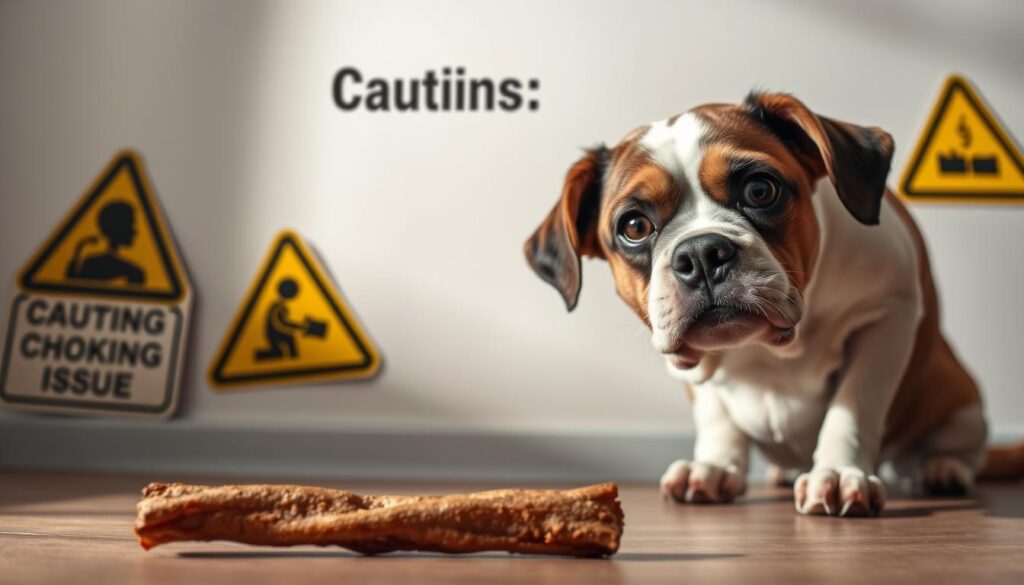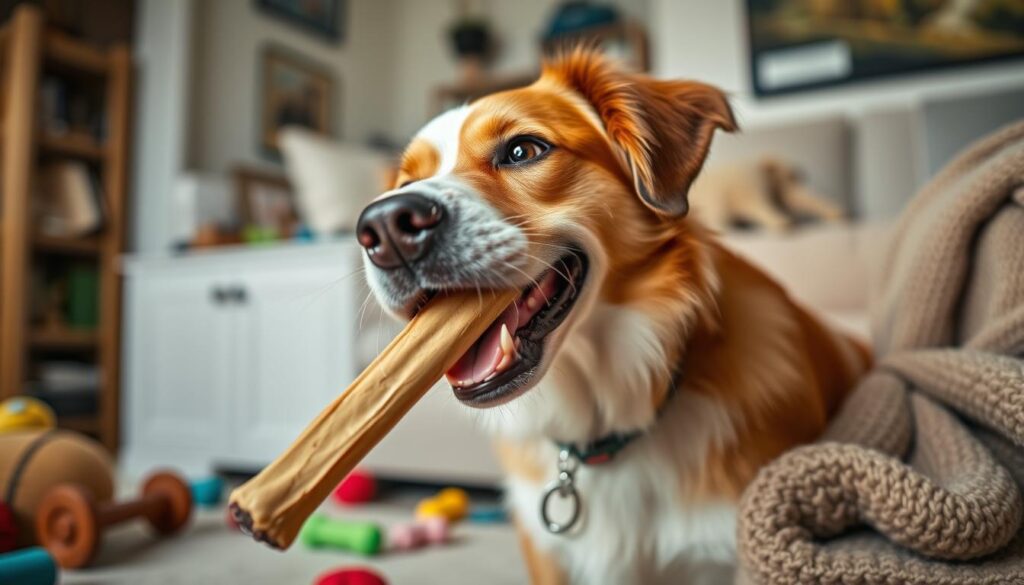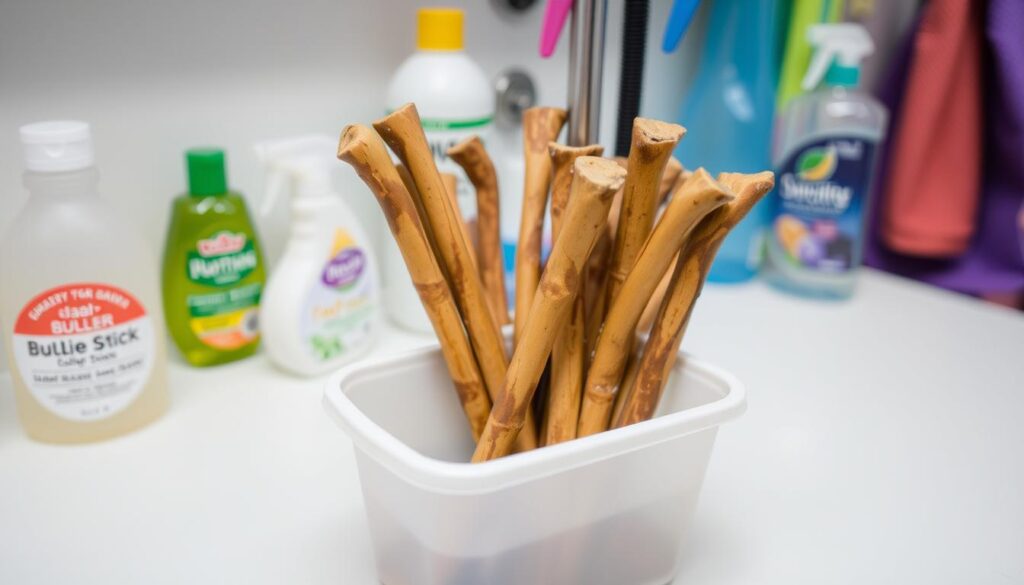Are Bully Sticks Safe for Dogs
As a pet parent, you want the best for your furry friend. Bully sticks are a popular choice, known for being natural and long-lasting. They offer many benefits for dogs. But, it’s important to know the safety concerns and how to use them safely.
In this guide, we’ll explore bully sticks in detail. We’ll look at their advantages, possible risks, and how to add them to your dog’s routine safely.
Bully sticks, also called “pizzle sticks,” come from a bull’s dried, stretched penis muscle. Their natural origin might surprise you. Yet, they’re loved for satisfying dogs’ chewing needs, improving dental health, and being a protein source.
When choosing bully sticks, it’s key to know about safety. This includes the right sizes, flavors, and how to store them. Always supervise your dog when they’re chewing on these treats.
What Are Bully Sticks: Understanding the Basics
Bully sticks are a favorite treat for dogs, loved for their health benefits. They are made from the bull pizzle, or the penis of a bull or steer. This makes them a great choice for pet owners looking for all-natural options.
Natural Composition and Processing
Bully sticks are special because they’re just beef muscle. They’re dried and shaped into various forms. This keeps their natural taste and avoids artificial additives.
Types and Varieties Available
- Standard Bully Sticks: The classic long, twisted shape
- Thick Bully Sticks: Providing a more substantial chewing experience
- Odor-Free Bully Sticks: Treated to reduce the natural aroma
- Braided Bully Sticks: Multiple bully sticks woven together
- Curly Bully Sticks: Spiral-shaped for a unique chewing challenge
- Junior Bully Sticks: Shorter length for smaller breeds or puppies
Quality Standards in Manufacturing
Good makers of bully sticks follow strict quality rules. They use bully stick ingredients from grass-fed, free-range cattle. This ensures a top-notch, all-natural dog treat.
The Benefits of Bully Sticks for Dogs
Bully sticks are a great treat for dogs, with many benefits. They are made from the pizzle of grass-fed cattle. These chews help with dental health, provide nutrients, and keep dogs mentally active.
Dental Health Advantages
Bully sticks are good for a dog’s teeth and gums. Chewing on them removes plaque and tartar. This is great for dogs with dental problems or who don’t like tooth brushing.
Nutritional Value and Protein Content

Bully sticks are high in protein, which is good for muscles, brain, skin, and coat. They are easy to digest, making them safe for dogs with sensitive stomachs or allergies.
Mental Stimulation and Enrichment
Chewing on bully sticks keeps dogs mentally sharp. It helps prevent boredom, stress, and anxiety. The variety in shapes, sizes, and textures makes chewing more interesting.
Bully sticks are a great treat for dogs. They help with dental health, provide nutrients, and keep dogs happy and active. They are safe and beneficial when bought from trusted sources and given under supervision.
| Bully Stick Benefit | Description |
|---|---|
| Dental Health | Helps remove plaque and tartar buildup, promoting healthier teeth and gums. |
| Nutritional Value | High-protein treat with essential amino acids that support overall health. |
| Mental Stimulation | Provides an outlet for natural chewing instincts, reducing boredom and stress. |
Are Bully Sticks Safe for Dogs: Expert Analysis
Bully sticks are a safe and good chew for dogs if used right. They are made from dried bull pizzle, which doesn’t splinter or break down. This reduces the risk of stomach problems or blockages.
Vets say bully sticks are great for dogs. They help clean teeth by removing plaque and tartar. They also keep dogs busy and satisfy their natural urge to chew. Plus, they are easy to digest and don’t have artificial stuff in them, which is good for dogs with food allergies.

But, it’s important to watch dogs when they chew on bully sticks. As the stick gets smaller, there’s a higher chance of choking or blockages. Vets say to take the stick away when it’s too small to swallow.
Choosing the right bully sticks is key. Look for high-quality ones from trusted makers to avoid bacteria like Salmonella or MRSA. These can be harmful to dogs and people.
In short, bully sticks can be a safe and good chew for dogs if used right. With the right care and attention, they can be a healthy treat for dogs.
| Chew Type | Pros | Cons |
|---|---|---|
| Rawhide Chews |
|
|
| Synthetic Chews |
|
|
| Natural Chews |
|
|
Choosing the Right Bully Stick Size and Type
Choosing the right bully stick is key for your dog’s happiness. Think about your dog’s size, age, and how they chew. The right size and type can keep them busy and healthy for a long time.
You May Like : Polish Lowland Sheepdog: The Perfect Blend of Loyalty and Charm
Size Guidelines by Breed
- Small Dogs (under 20 lbs): Thin bully sticks, 4-6 inches long, are best for small breeds and puppies.
- Medium Dogs (20-50 lbs): Standard-thickness sticks, 6-8 inches, fit most medium-sized dogs.
- Large Dogs (over 50 lbs): Thick or braided sticks, 8-12 inches, are great for big dogs to chew on longer.
Different Shapes and Textures
Bully sticks come in many shapes and textures. Straight sticks offer a classic chew. Curly or braided ones add a fun twist. Thicker sticks are best for dogs who chew a lot.
Duration and Replacement Recommendations
Replace bully sticks when they’re too small for your dog to swallow, about 2.5-3 inches. Limit them to one a day to avoid health issues. Always watch your dog while they chew to keep them safe and happy.
Safety Guidelines and Best Practices
Keeping your dog safe is key when giving them bully sticks. These treats are good for their teeth and mind. But, it’s important to follow safety rules and best practices to avoid risks.
- Supervised Chewing: Watch your dog when they chew on a bully stick. This way, you can stop them if it’s a choking risk.
- Gradual Introduction: Begin with short chew times, like 5-10 minutes. Then, you can increase it as they get used to it. This helps avoid upset stomachs.
- Size Considerations: Pick the right size bully stick for your dog. Big dogs need longer, thicker sticks. Small dogs do better with smaller ones.
- Allergy and Sensitivity Monitoring: Watch for signs of allergies or stomach problems like vomiting. Stop giving them bully sticks if you see any bad signs.
- Proper Handling and Storage: Clean your hands after touching bully sticks to avoid germs. Keep unused sticks in a cool, dry spot. Throw away any that smell bad or look off.

By sticking to these safety tips, you can make sure your dog enjoys bully sticks safely. Always watch your pet to keep them safe and happy while chewing.
| Breed Size | Recommended Bully Stick Size |
|---|---|
| Small (under 20 lbs) | 4-6 inches |
| Medium (20-50 lbs) | 6-8 inches |
| Large (over 50 lbs) | 12+ inches |
Common Concerns and Misconceptions
Bully sticks are often seen as safe and natural treats for dogs. Yet, there are a few concerns pet owners should know about. One worry is the choking hazard when the stick gets smaller. It’s important to pick the right size for your dog and watch them while they play.
Another worry is how well dogs can digest bully sticks. Most dogs can, but some might get upset stomachs if they eat too much too fast. Start with small amounts and slowly increase it to help your dog’s stomach get used to it.
Bully sticks also have a lot of calories. This means they can add up to a dog’s daily calorie count, leading to weight gain. A 6-inch stick has about 88 calories, which is a lot for a small dog.
Some dogs might also have allergies to the proteins in bully sticks. If your dog shows signs of an allergy, like skin problems or upset stomach, stop giving them bully sticks and talk to your vet.

There’s also a worry about bacteria like Clostridium difficile, MRSA, and E. coli. But, choosing high-quality bully sticks and using a Bully Stick Companion can help avoid these risks.
Knowing these concerns and taking steps to prevent them can help pet owners enjoy bully sticks safely. This way, they can keep their dogs happy and healthy.
How to Introduce Bully Sticks to Your Dog
Introducing bully sticks to your dog can be fun for both of you. These 100% beef muscle treats are high in protein. They can help with dental health and keep your dog’s mind active. But, it’s important to introduce them slowly and safely.
Begin with short, watched sessions of 5-10 minutes. This helps your dog get used to the new treat without eating too much. If your dog seems fine, you can make the sessions longer.
Watch how your dog chews and pick the right size or type of bully stick. If they swallow treats quickly, choose a thicker or longer stick. If they find it too hard, try dental toys or veggies instead.

- Introduce bully sticks in short, supervised sessions of 5-10 minutes.
- Gradually increase the duration if your dog shows no adverse reactions.
- Observe your dog’s chewing style and adjust the bully stick size or type as needed.
- Consider alternative chews like dental toys or vegetables if your dog shows disinterest or digestive issues.
- Praise your dog for appropriate chewing behavior.
- Use bully sticks as occasional treats, not meal replacements.
Always watch your dog when they have a bully stick. Take it away when it’s too small to avoid choking. By following these steps, you can add bully sticks and other treats to your dog’s diet safely. This will make their chewing time fun and healthy.
Storage and Maintenance Tips
Keeping your dog’s bully sticks fresh and safe is key. Follow these tips to ensure their quality and safety:
Proper Storage Methods
Keep unused bully sticks in a cool, dry spot. Stay away from sunlight and moisture. Don’t put them in the fridge, as it can cause bacteria to grow. If your dog has chewed on a stick, let it dry or gently pat it with a clean towel before storing.
Cleaning and Sanitization
Clean up after your dog has had a bully stick. Check stored sticks for mold or bad smells often. If you find any, throw them away to keep your dog safe. Always follow the package’s storage advice, usually up to three years for unopened ones.

| Bully Stick Shelf Life | Proper Storage Conditions |
|---|---|
| Approximately 36 months (3 years) | Cool, dry place, away from direct sunlight and moisture |
By sticking to these dog treat storage and bully stick hygiene tips, you’ll keep your dog’s pet food safety in check. This way, they can enjoy a healthy, long-lasting chew.
Conclusion
Bully sticks are great for dogs. They help with dental health, keep minds sharp, and are nutritious. They are safe and fun for dogs when used right. But, it’s important to pick the right size and watch your dog while they chew.
Following safety tips, pet owners can give bully sticks to their dogs. These natural chews can fight plaque, entertain dogs, and add to a healthy diet. They are a great choice for dog treats.
With care and attention, bully sticks are good for dogs of all ages and sizes. Dog owners need to know the benefits and risks. This way, they can make sure their dogs enjoy these treats safely and wisely.
FAQ
What are bully sticks made of?
Bully sticks are treats made from 100% beef muscle, from bull penis. They lose moisture and are shaped into different forms.
What are the different types of bully sticks?
There are many types, like standard, thick, and odor-free. You can also find braided, curly, and junior bully sticks. They come from grass-fed cattle and are free from artificial stuff.
What are the benefits of bully sticks for dogs?
They help keep teeth clean by removing plaque and tartar. They also give dogs amino acids for muscle and skin health. Plus, they keep dogs busy and happy.
Are bully sticks safe for dogs?
Yes, they are safe if used right. They don’t break like bones and are easy to digest. But, big pieces can be a choking hazard. Always watch your dog and take away the stick when it’s too small.
How do I choose the right bully stick size and type for my dog?
Pick based on your dog’s size, age, and how they chew. Big dogs might need thicker sticks, while small ones or puppies do better with thinner ones. Different shapes offer different textures and challenges.
How should I store and maintain bully sticks?
Keep them in a cool, dry place, away from sunlight and moisture. Don’t refrigerate them as it can cause bacteria to grow. If a stick is half-chewed, let it air dry or pat it dry with a towel before storing. Clean up after use and throw away any damaged sticks.
What are the common concerns and misconceptions about bully sticks?
Choking can be avoided with the right size and watching your dog. They are easy to digest but can upset a dog’s stomach if eaten too fast. They are high in calories, so count them in your dog’s diet. Some dogs might be allergic or find them smelly, but there are odor-free options.
How do I introduce bully sticks to my dog?
Start with short, watched sessions of 5-10 minutes. If your dog does well, you can make the sessions longer. Watch how your dog chews and change the stick if needed. If they don’t like it or have tummy troubles, try other chews like toys or veggies.


